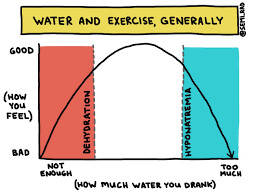Running News Daily
Running News Daily is edited by Bob Anderson. Send your news items to bob@mybestruns.com Advertising opportunities available. Train the Kenyan Way at KATA Kenya and Portugal owned and operated by Bob Anderson. Be sure to catch our movie A Long Run the movie KATA Running Camps and KATA Potato Farms - 31 now open in Kenya! https://kata.ke/
Index to Daily Posts · Sign Up For Updates · Run The World Feed
Is Overhydration More Dangerous than Dehydration?
Here's why you need to monitor your water intake
Being human is all about balance. We strive to find an ever-elusive equilibrium between work and life. We go to yoga classes in hopes of improving our physical steadiness. We eat an assortment of fruits and vegetables, but we also munch on chips and dip. And, from a physiological standpoint, our blood cells need balance, too.

As athletes—especially ones who spend time outdoors during a heat wave—the ethos we usually hear is “hydrate, hydrate, hydrate.” However, a 2020 research article from Stanford University School of Medicine offers a different perspective. In the piece, the study’s lead author notes that overhydrating is actually more dangerous than being dehydrated.
One of the most important things to maintain balance in our blood cells is the sodium-to-water ratio, says Tamara Hew-Butler, associate professor of exercise and sport science at Wayne State University School of Medicine. When you’re dehydrated, you contain less water, causing your blood cells to shrink. However, when you drink some H2O, your cells recover quickly.
When you consume a lot of water (more than three liters in an hour), your sodium levels dip to abnormally low levels, taking you into dangerous territory. If the water count in your body is much higher than your sodium levels, you can develop hyponatremia—a dangerous result of overhydration. “If you drink too much water, all of your cells start to swell,” Hew-Butler says. “That becomes a problem in your brain, because your brain can only swell five to eight percent [beyond its normal size] before it runs out of space in the skull.”
It’s not something to be taken lightly. In some cases, hyponatremia can lead to death, Hew-Butler says. “The amount of water that leads to hyponatremia is different for everyone,” she adds. “It depends on the size of the person, the ambient temperature, and exercise intensity and duration.” However, if you need to quantify it, typically drinking about three liters of water within an hour can cause severe hyponatremia, potentially prompting a seizure, coma, or even death, Hew-Butler says.
Overhydration is a particularly large concern during the summer months. “The first thing that everybody tells you—and it’s not always wrong—is to drink lots of water,” Hew-Butler says. “But, when it’s hot out, more people die from overhydration than they do from dehydration.”
That’s because your blood cells actually retain water as a result of the heat, so you’re not quite as dehydrated as you may think.
This isn’t necessarily new information, Hew-Butler says. “The results of a 1999 study in the American Journal of Emergency Medicine support that hyponatremia is [generally] more common than heatstroke.” She adds that it’s the most common cause of serious illness in the Grand Canyon—more than heat exhaustion, grand mal seizures, nausea, and dizziness.
What should you do to achieve that balance of hydration? Drink to thirst, recommends Allen Lim, a sports physiologist and the founder of sports nutrition brand Skratch Labs. (So yes, that means skipping out on your emotional support water bottle.) However, even when you’re feeling parched, make sure to monitor your H2O intake.
“During exercise, the thirst mechanism will prioritize [sodium] balance over water balance,” Lim says. “As we lose sodium in our sweat, we will naturally drink less water to maintain sodium balance. Since there’s not as much sodium in the body, we don’t drink everything we lose, so we can keep the ratio of water to sodium the same.” Essentially, your body makes you thirsty when that sodium-to-water ratio is skewing high on sodium. And that’s when you should drink water.
You know that old saying, “Listen to your body?” That’s sage advice when it comes to hydration, especially when it’s hot out. “Drinking to thirst is important even though it can result in dehydration,” says Lim. “That dehydration is important to keep the sodium balance correct.”
by Outside Online
Login to leave a comment




